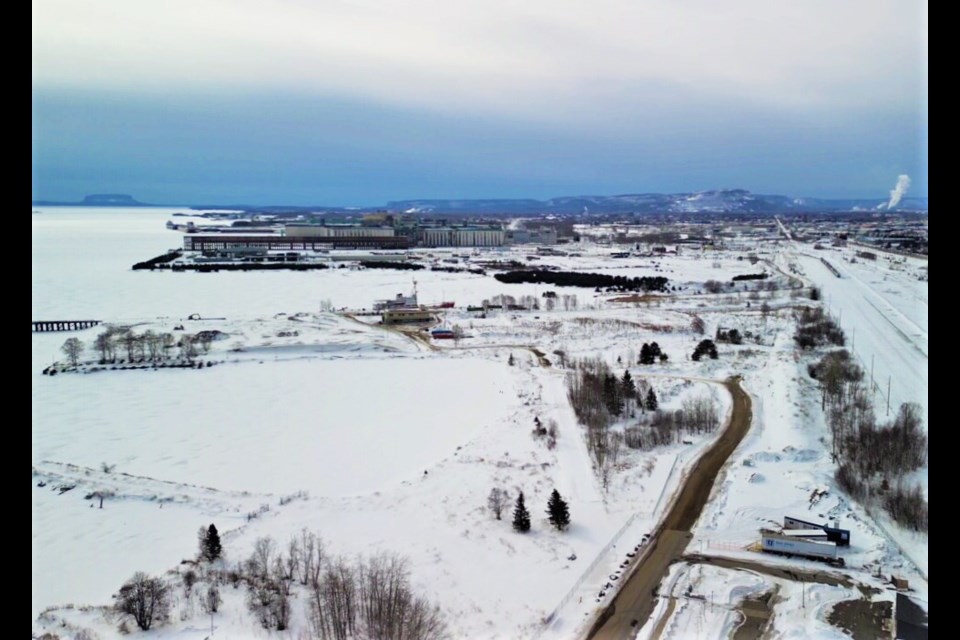THUNDER BAY — City staff have outlined their intention to update a “master plan” for the Pool 6 lands, setting the stage for further development of the city’s waterfront south of Prince Arthur’s Landing.
The master plan will complement a “best use” study the Thunder Bay Community Economic Development Commission is already carrying out to explore economic development scenarios for the former industrial lands.
Kayla Dixon, the city’s director of engineering and operations, said the plan will largely be based on feedback collected from the public and key stakeholders.
Developments at Pool 6 could be “transformative” for the city, in much the same way as the construction of Prince Arthur’s Landing, which began in 2009.
Dixon will present city council with an update on Monday, indicating administration’s plans to conduct consultation over the coming months, and return with an updated plan in late 2023 or early 2024.
The Pool 6 lands, which bear the name of the grain elevator that once stood on the site, sit directly south of Prince Arthur’s Landing and the future site of the Thunder Bay Art Gallery.
Science North has also already announced Pool 6 as its preferred site for a proposed science centre, a prospect widely welcomed by local leaders but still in the development phase.
That’s among the new developments Dixon said led staff to propose updating the 2015 plan.
“Considering the opportunities that are presenting themselves down at the waterfront now — we do have a growing Great Lakes cruise ship industry, as well as developers who are interested in the land, including Science North — certainly it’s a good time to update that plan,” she said.
The plan could be crucial in informing what kinds of development take place on the lands, with consultation in 2015 indicating the public preferred plans emphasize green space and public recreation opportunities.
The economic development commission's best use study, meanwhile, will consider integrating public amenities with private uses that could include housing or hotel developments.
The 2015 master plan envisioned uses including a mountain biking and skating area, Nordic spa, a large multi-use field, and a pavilion for cruise ship visitors.
Some of those ideas may remain in the updated plan, while others could be discarded.
“We haven’t had interest yet from a private developer looking at a Nordic spa option, so [the plan will ask], is now a good time to change those uses? But certainly looking for the community to come out and say if they still are interested in the multi-use field, large areas for recreation and sport.”
Coun. Andrew Foulds, recently appointed as chair of the city’s waterfront development committee, which will be involved in the master plan process, agreed the timing is right.
He said the updated plan will play a key role in the next stage of developing Thunder Bay’s waterfront, which he said is “on the cusp of greatness” after investments at Prince Arthur’s Landing.
“This is potentially very exciting,” he said. “I think what the City of Thunder Bay has been able to accomplish on the waterfront has been herculean, and has really changed the dial in terms of the city and the experience that not only visitors have, but the people who live here.”
“I’m really seeing this as a positive opportunity [to ask] what’s next for our waterfront.”
He said some of the guiding principles identified in the 2015 plan remain important, such as public access, environmental regeneration, and incorporating Indigenous culture (ideas like a roundhouse or sweat lodge were suggested).
He hopes some of the ideas to help residents connect with nature that were included in the 2015 plan, like greater water access including a potential fishing dock, could become a reality.
While he called those public uses the top priority, Foulds said he doesn’t rule out the possibility of supporting private development as well.
“At this point in time, I’m not going to get dogmatic, because we’re going to go through a process in terms of revising the master plans, and seeing what the public’s desires are. So I’m not going to say right now absolutes on anything.”
Environmental assessments are also being carried out on the lands, which for nearly a century were home to industrial activity after being filled in (the original shoreline was further to the west, parallel to Water Street).
Dixon said she doesn’t yet have information on what kind of rehabilitation could be required.
Foulds indicated there could also be some archaeological limitations to development.
The master plan is expected to be presented to council in late 2023 or early 2024, allowing it to incorporate findings from the economic development commission's best use study, which is set to wrap up in June.
Staff plan to launch a public survey at the city’s Get Involved website beginning in April, before conducting targeted consultation with stakeholders including business, Indigenous groups, area condo boards, the Lakehead Transportation Museum, and representatives of the cruise ship industry.
